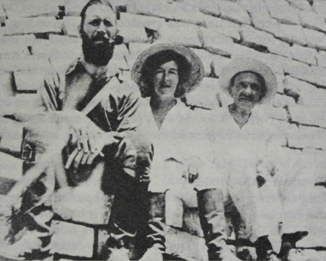F. A. Mitchell-Hedges: Credibility Problems

Mitchell-Hedges, Lady Richmond Brown and Dr. Thomas Gann at Lubaantun.
While Anna Mitchell-Hedges claims to have found the skull, there is no doubt that it is her father who got the skull off to a good start with respect to its modern mythos. The skull is named after him and it is he who started the "skull of doom" legends.
Determining the truth about the skull's history means taking a good look at the credibility of F. A. Mitchell-Hedges.
To be blunt, it pays to be skeptical when dealing with his claims. Those who knew him portray him as a "charming rogue" who led an exciting life in which veracity was not nearly as important as adventure. At one point in his career he was labeled "the British Baron Munchausen."
He would often make sweeping claims based on insufficient evidence (such as his contention that the Crystal Skull "proved" the historical existence of Atlantis), and his autobiography does not always square with historical documentation (such as his account of General Pershing marching to the Mexican border two years before he actually did so).
Mitchell-Hedges once lost a libel suit against the London Daily Express, who had written that he had faked a robbery of his own goods for publicity reasons. In an article in the New York Evening Post of February 14, 1928 entitled "Mitchell Hedges Loses Libel Suit and 'He-Man' Halo," many of the details of the trial were made public.
Evidently, Mitchell-Hedges had made a splash in England by giving lectures and writing articles extolling the virtues of being a "he-man," all the while scolding English boys for being soft. Shortly thereafter, he staged a fake hold-up in which he was "robbed" of a suitcase containing papers which he told the police would prove seriously compromising to certain VIPs if they fell into the wrong hands. In the luggage were some archeological relics, and four shrunken heads.
Less than 24 hours after the robbery, the whole thing was admitted to have been a hoax and the suitcase was returned. The young men who took part in the hoax said that they had done it to demonstrate that British youth still had some courage. During the trial, it was revealed that the chauffeur of the car Mitchell-Hedges was in (when he was lured into a country lane at night so that the robbery could be effected) had voluntarily allowed himself to be tied up. According to the aforementioned New York Evening Post article, it was testified that after the "robbery," Mitchell-Hedges said: "Now, boys, be off, I'll take care of myself." Under grueling examination, Mitchell-Hedges revealed that parts of his autobiography in Who's Who had been fictionalized. The entry indicates that he studied at Cambridge, when in fact it should have read University College school. He admitted that the tribe of Indians he had supposedly discovered had in fact been discovered by Balboa. One set of rather imposing initials after his name really only resulted from his having joined the London Zoological Society, entitling him to enter the zoo on Sundays.
Based on exhaustive research and interviews, I have to assign Mitchell-Hedges a very low credibility rating.
PREVIOUS (The Mitchell-Hedges Skull) | NEXT (Frank Dorland on the Crystal Skull)
The Crystal Skull Contents | strangemag HOME